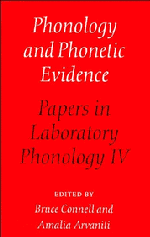1 - Introduction
Published online by Cambridge University Press: 03 May 2011
Summary
This, the fourth volume in the Papers in Laboratory Phonology series, is based on papers originally presented at the Fourth Conference on Laboratory Phonology, held at the University of Oxford in August 1993.
The first Laboratory Phonology conference (LabPhon) was held in June 1987, with its major stated aim the breaking down of barriers between phonetics and phonology. Since that time, laboratory phonology has rapidly become established, if not as mainstream in phonology circles, then certainly as a well respected approach to studying the organization of sound systems. Testament to this can be seen equally in the success of the subsequent LabPhon meetings (in Edinburgh, UCLA, and Oxford), the increasing input from younger scholars at these meetings, and the growing number of papers in major journals reporting research done from the laboratory phonology perspective.
Laboratory based phonology papers can be frequently found in journals such as Language and Speech (e.g. de Jong, Beckman & Edwards, 1993), Journal of Phonetics (e.g. Zsiga, 1994), Phonetica – which has featured theme issues on the relation between phonetics and phonology, and on Articulatory Phonology, a theory whose own growth and development is intimately connected to that of Labphon – and Phonology (e.g. Gussenhoven, 1991; Keating, 1988; Maddieson & Precoda, 1992; Trigo, 1991). With the exception of Phonology, the slant of these journals has traditionally been towards phonetics, which might suggest that in achieving the desired rapprochement between phonetics and phonology, it is mostly the phoneticians who have taken on board the view that their work would benefit from phonological input.
- Type
- Chapter
- Information
- Phonology and Phonetic EvidencePapers in Laboratory Phonology IV, pp. 1 - 4Publisher: Cambridge University PressPrint publication year: 1995
- 1
- Cited by



